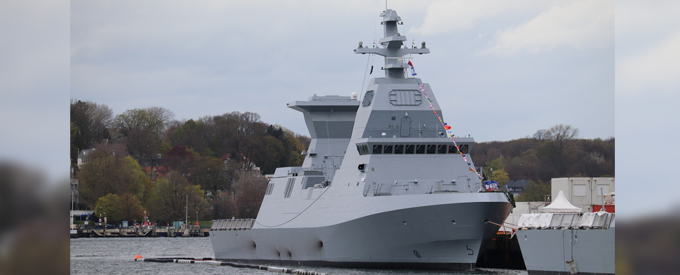2021-06-06
thyssenkrupp Hands Over INS Oz to Israel
German shipbuilder thyssenkrupp Marine Systems has officially handed over the second of four SA’AR 6 corvettes to the Israeli Navy. The handover ceremony for INS Oz was held in Kiel on May 4.
In the presence of Jeremy Issacharoff, the Israeli ambassador to Germany, his wife, Laura Kam Issacharoff, first named the ship INS Oz.
Subsequently, thyssenkrupp Marine Systems Managing Director Dr Rolf Wirtz officially handed over the ship to the Israeli Navy at a low-key ceremony following very strict COVID-19 prevention measures at the shipyard.
In the world of shipping, it is a favoured tradition to pass on the names of such ships. For the Israeli Navy, however, the INS Oz is the first vessel to receive this name.
Dr Wirtz remarked: “As the first ship in the history of the Israeli Navy with this name, the INS Oz will establish a new tradition. We are convinced of this here at thyssenkrupp Marine Systems, because she has everything it takes. We are very proud that, after the first-of-class, this is now the second vessel to receive this honour.”
The SA’AR 6-class corvettes will form the backbone of the Israeli Navy for the next 30 years.
Rear Admiral Ariel Shir had arrived in Kiel for the occasion of naming and handover: “This is a great and historic day for the State of Israel, the Israel Defence Forces and, of course, the Israeli Navy. This is a day when a vision becomes reality. A day when we can see this vision in all its grandeur, thanks to the hard work tirelessly contributed by so many.”
In May 2019, the first SA’AR-6 class missile corvette was christened INS Magen. It was handed over to the Israeli Navy in November last year.
The ships have the stealthy design of a low-signature missile corvette with tailor-made solutions and numerous new technologies on-board.
The contract for the delivery of four SA’AR 6 corvettes - performed by thyssenkrupp Marine Systems (Lead) and project partner German Naval Yards Kiel - was signed in May 2015.
After the design phase, the construction phase started with the steel cutting ceremony of the first-of-class in February 2018.
Only 15 months after the first steel cut, the ship was undocked, fulfilling its very ambitious schedule. The following two units of the series are also scheduled for delivery later this year.
Radar and Weapon Systems
The Israeli Navy is itself equipping the corvettes with radar and weapon systems.
According to information published by the Israeli Ministry of Defence in February 2021, an advanced naval version of the Iron Dome air defence missile system will be installed onboard the new SA’AR 6 corvette of the Israeli Navy.
The SA’AR 6 corvette is armed with one Oto Melara 76 mm main gun, two Typhoon remotely-operated weapon station armed with 25mm automatic cannon, 32 vertical launch cells for Barak-8 surface-to-air missiles, 40 vertical launch cells for C-Dome point defence system mounted at the front deck, 16 Gabriel missile (Gabriel V anti-ship missile) and two 324 mm (13 inches) torpedo launchers.
The SA’AR 6 corvette encompasses the naval version of the Iron Dome, dual mission counter rocket, artillery and mortar (C-RAM), and Very Short Range Air Defence (VSHORAD) system, named C-Dome.
The C-Dome is designed to protect combat vessels against aerial threats. The system handles saturation attacks by engaging multiple targets simultaneously. The reaction time is rapid and enables automatic and semi-automatic engagements.
The original dome is designed to intercept and destroy short-range rockets and artillery shells fired from distances of 4 km to 70 km away. The advanced version will be able to intercept targets at a maximum range of 250 km.
The corvettes are also covered in some 260 static radar arrays that allow them to detect incoming projectiles and aircraft in the sky, as well as ships and low-flying cruise missiles at sea level.
In the past, a ship would have needed two separate radar systems, one to detect objects at sea level and one to scan the skies. That the 260 or so arrays stay in place also means that the ship is less easily detectable than vessels with radar systems.


No Comments